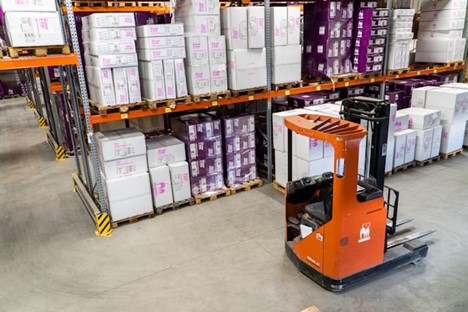John DiTonno

John C. DiTonno: A Veteran in Logistics and Operations
John C. DiTonno is a seasoned professional with over 30 years of experience in transportation, warehousing, and logistics. Throughout his career, John has demonstrated exceptional leadership, operational expertise, and a commitment to optimizing supply chain processes. His robust skill set and proven track record make him a valuable asset to the industry.
A Proven Leader in Operations and Supply Chain
John DiTonno’s journey in the logistics industry began three decades ago, and since then, he has honed his management skills and built strong relationships with key stakeholders. He has overseen complex supply chain operations, driven revenue through strategic inventory controls, and consistently met corporate objectives.
Transforming Supply Chain Networks
At Premier Packaging, John DiTonno played a pivotal role in expanding the company’s 3PL network from 44 to 68 providers to support packaging storage and delivery to major clients like Amazon Fulfillment Centers and Whole Foods Markets. As a key decision-maker, he led 3PL provider searches, conducted site selection, and evaluated facilities to ensure the best fit for the company’s needs. This expansion not only improved operational efficiency but also contributed to the company’s growth and success.
Excellence in Industrial Engineering
Before his tenure at Premier Packaging, he served as an Industrial Engineering Manager at UPS Supply Chain Solutions, where he managed a network of over 30 facilities along the East Coast. These facilities, ranging from 50,000 to 400,000 square feet, served a diverse customer base, including healthcare, pet food, clothing, automotive, and high-tech industries. John DiTonno’s responsibilities encompassed staffing, safety, service, quality, key performance indicators (KPIs), and financial management.
His role required conducting work measurement analysis, implementing process improvements, and justifying capital projects such as facility layout, rack design, conveyor systems, pick-to-light, voice picking, and pick tunnel designs. Through his efforts, he successfully improved operational efficiency and reduced costs, further solidifying his reputation as a strategic leader in logistics.
Achievements and Impact
John’s accomplishments in various roles have had a significant impact on the organizations he served. At Premier Packaging, he was instrumental in reducing supply chain costs by 26% and achieving a 21% reduction in service quality issues and on-time performance. He evaluated and launched transportation lanes for national and local deliveries, optimizing routes for maximum efficiency and establishing strong relationships with key vendors and suppliers.
During his time at UPS Package Operations, John C. DiTonno managed an 80-package car delivery center, handling 17,000 stops and 52,000 packages daily. He built a motivated team of 85 drivers, resolved union conflicts, and maintained excellent relationships with local union management. His safety initiatives led to a record-setting 0/0 accident/injury rate for six months, a feat that hadn’t been achieved in five years locally.

Skills and Expertise
John’s expertise extends beyond logistics and supply chain management. He is skilled in operational strategy development, budget management, process improvement, team leadership, and vendor and supplier relationship management. His approach to performance measurement and continuous improvement has been a key factor in his success.
John C. DiTonno’s extensive experience in transportation, warehousing, and logistics, coupled with his strategic mindset and leadership skills, make him an essential part of operational excellence and supply chain dynamics. His track record of driving cost savings, enhancing efficiency, and leading successful teams underscores his ability to deliver results in challenging environments.
With a comprehensive background in logistics and operations, John DiTonno is poised to make a significant impact in any organization seeking to strengthen its central operations and improve its overall performance.
Maximizing Efficiency in 3PL Warehouses
Third-party logistics (3PL) warehouses are the backbone of modern supply chains, providing a crucial link between manufacturers, retailers, and customers. As consumer expectations continue to rise and e-commerce grows, the pressure to increase efficiency in 3PL operations has never been greater. Below, John DiTonno explores effective strategies for streamlining 3PL warehouse operations to improve productivity, reduce costs, and enhance customer satisfaction.
Understanding the Challenges
3PL warehouses face unique challenges due to the complexity of managing multiple clients’ inventory, accommodating diverse product types, and handling fluctuating order volumes. These challenges can lead to inefficiencies, increased labor costs, and longer delivery times if not properly managed. However, with the right strategies and technologies, 3PL warehouses can achieve significant efficiency gains.
Streamline Inventory Management
A key factor in maximizing efficiency is effective inventory management. 3PL warehouses should implement advanced inventory tracking systems, such as barcode scanners and radio-frequency identification (RFID), to monitor stock levels in real-time. This technology reduces the chances of overstocking or stockouts, ensuring that orders are fulfilled promptly.
Implementing inventory forecasting tools can also help predict demand patterns, allowing warehouses to adjust their stock levels accordingly. This proactive approach reduces excess inventory and minimizes the need for last-minute restocking.
Optimize Warehouse Layout
The layout of a 3PL warehouse significantly impacts productivity. An efficient warehouse layout minimizes unnecessary movement, reduces travel time, and facilitates easy access to frequently picked items. To achieve this, consider the following:
- Zoning: Divide the warehouse into different zones based on product type, picking frequency, and shipping destinations. This approach streamlines the picking process and reduces congestion.
- Slotting: Arrange products based on their turnover rates, placing high-demand items near shipping docks for quicker processing. This reduces travel time and expedites order fulfillment.
- Vertical Storage: Utilize vertical storage solutions, such as mezzanines and tall shelving units, to maximize storage space without expanding the warehouse footprint.

Invest in Automation and Technology
John C. DiTonno explains that automation plays a significant role in improving efficiency in warehouse management. Automated systems reduce manual labor, minimize errors, and accelerate order processing. Some automation solutions to consider include:
- Automated Storage and Retrieval Systems (AS/RS): These systems use robotic technology to move and retrieve products within the warehouse, reducing the need for manual labor and speeding up order fulfillment.
- Warehouse Management Systems (WMS): A robust WMS helps manage inventory, track orders, and optimize workflows. It can integrate with other systems, such as transportation management systems, for seamless logistics coordination.
- Automated Material Handling Equipment: Invest in conveyor belts, sorters, and automated guided vehicles (AGVs) to streamline the movement of goods within the warehouse.
Focus on Workforce Training and Safety
A well-trained and motivated workforce is essential for efficient 3PL warehouse operations. Provide comprehensive training programs to ensure employees understand the warehouse processes, safety protocols, and equipment usage. Encourage cross-training to create a flexible workforce that can adapt to changing demands.
Safety should be a top priority in the logistics industry. Implement safety protocols, conduct regular safety audits, and provide employees with the necessary protective equipment. A safe working environment reduces accidents, minimizes downtime, and boosts employee morale.
Embrace Data Analytics for Continuous Improvement
Data analytics can provide valuable insights into warehouse operations, allowing 3PL companies to identify bottlenecks, track performance, and make data-driven decisions. Implement a data analytics platform to monitor key performance indicators (KPIs) such as order accuracy, pick rate, and on-time shipping.
Use this data to drive continuous improvement efforts, identifying areas for process optimization and implementing best practices. John C. DiTonno says that by embracing a culture of continuous improvement, 3PL warehouses can maintain efficiency and stay ahead of the competition.
Maximizing efficiency in 3PL warehouses requires a combination of advanced technology, optimized processes, and a skilled workforce. By streamlining inventory management, optimizing warehouse layout, investing in automation, prioritizing safety, and leveraging data analytics, 3PL companies can achieve significant productivity gains and meet the demands of an ever-evolving supply chain landscape. Follow the blog for the latest news.